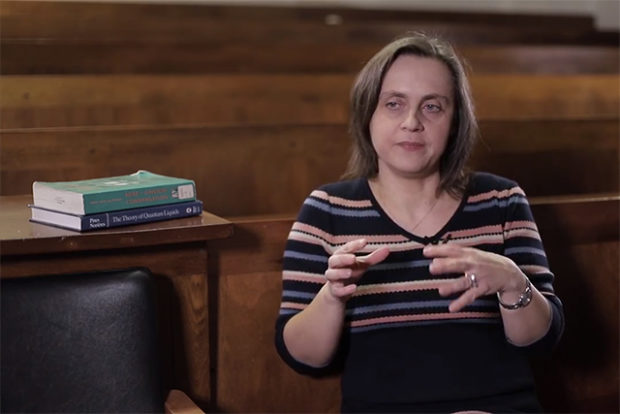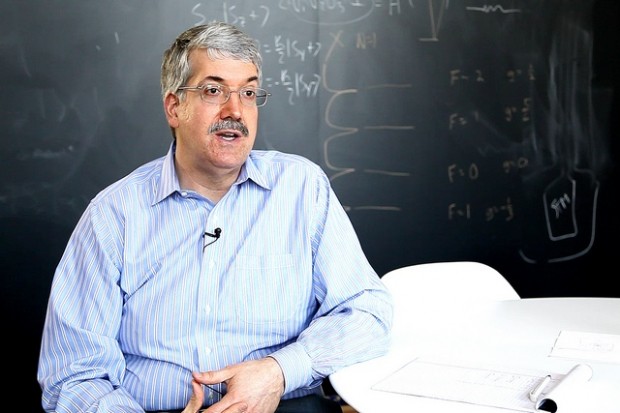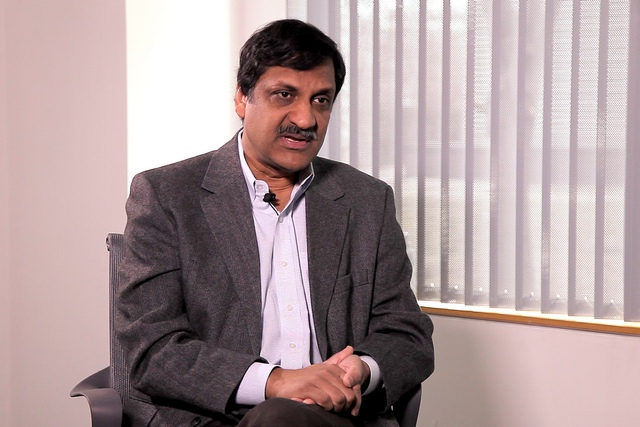Superfluidity of Light
Physicist Marzena Szymanska on the properties of photons, fluids of light and whether it’s possible to make a solid light
videos | October 1, 2020
If you think of photons, you may wonder why we do not have a complex form made from light. For example, if you have other particles such as electrons and atoms, they form complex structures, they form liquids, they form solids. All the world around us is made from matter, which is basically quarks and leptons. But why can’t we make similar things with light?
Light is a boson, so in principle, we could achieve a fluid of light or even a superfluid of light or maybe even a solid of light. So why has that not been possible so far?
So, one reason is that photons do not interact: the cross-section of the interaction between two photons is very small. In optical frequencies, in principle, the photons could interact via the creation of electron-positron pairs, but in practice, it doesn’t happen because the process is extremely unlikely. So, photons do not interact, and this is one of the limitations of why we cannot create complex structures. Another limitation is that the photons are massless; the rest of the mass of the photons is zero. For any complex structure that is liquid or solid to be built, there is a competition between kinetic and potential energy, so if photons do not have a mass and they don’t interact, we don’t have this notion, and we cannot create more complex forms made of photons. However, this can be overcome nowadays; we can cheat nature. We can give the photons a mass artificially, and we can give photons interactions. So how can we do that?
To give a photon a mass, it’s enough to capture the photons in one direction. If you can create mirrors such that the photons will not escape outside, the motion will be frozen in one direction; it will only be possible to move in one direction perpendicular to those mirrors; effectively, it will mean that in these two other directions, the photons are massive. This mass will be finite, but it will be very small, so it will be of the order of 10-9 of typical atoms. This is actually quite useful because if the masses are light, then any quantum effect would appear at very high temperatures, even up to room temperature. So, we can fix the problem of the mass by capturing the photons between two mirrors.
The problem of interactions between photons can also be solved if you couple the photons to something of a matter type because if the photons annihilate and create, let’s say, an exciton or if they couple to some internal degrees of freedom inside an atom, for example, then via that other object the photons will effectively interact.
This was possible to achieve either in semiconductor structures with electron-hole pairs, so excitons, or atoms placed in cavities where interaction between photons could be achieved via coupling to these internal atomic degrees of freedom.
So you could solve these two problems: the mass and the interaction between photons. Because that was possible in experiments to be done, we could make photons interact inside that cavity and in experiments, we were able to actually create a fluid of light, so interacting photons with a mass is very similar to any other fluid. In particular, because the mass is so light, it was possible to achieve quantum effects such as, for example, superfluidity at very high temperatures.
So, it was possible to create photons coupling them to electron-hole pairs in semiconductors, forming polaritons. Once the quantum fluid of the superfluid was created, it allowed the injection of quite an interesting object: we could put vortices inside such a superfluid, we could inject persistent currents into the superfluid, and observation of the frictionless flow was possible. Our photons were doing a very similar thing to liquid helium or electron-hole pairs in semiconductors, flowing without resistance, not seeing any obstacle on the way and supporting persistent current, supporting vortices.
So then we went a step further in experiments in various groups, looking at the transition between a normal state and the superfluid state in the case of these interacting photons. It was possible to see that the transition between a normal state and the superfluid state, very similar to the matter particles, is happening via the creation and annihilation of vortex-antivortex pairs, so binding and unbinding of those pairs, in the same spirit as Kosterlitz-Thouless transition. So we already had our quantum fluid, which now can be used as a laboratory to explore quantum turbulence, the behaviour of the vortices, and the behaviour of the solitons, but now we wanted to go one step further. Now we have a fluid; we have a superfluid; why can’t we create a solid out of light?
And that’s a very new area of research at the moment. We can do that; we can create a potential for light. There are various ways of doing that technologically: one can put different pieces of a different material with a different refractive index on the top of our mirrors, giving effective potentials for light, or one can put surface acoustic waves to modulate the energy of photons via external soundwaves. Instead of having a two-dimensional structure, one can make one-dimensional lattices out of the semiconductor.
So there are various ways of creating potentials for photons, and if now you place a photon which has a mass and interactions inside a potential, then you’ll create something that’s just the same as in the case of a solid.
Why would we be interested in doing that? As I said, the photons have a very small mass, so the quantum effects are happening at very high temperatures. So now, by creating these artificial lattices for photons, we can try to model to quantum simulate some other materials which are much more complicated to study than photons. Moreover, this is already quite an active field in the area of ultracold atoms, but ultracold atoms have their limitations. Firstly, they have to be cooled to extremely low temperatures, and here, with photons, we can be almost at room temperature: that’s one advantage of that system. Another advantage is that the mirrors are never ideal, so there will always be some leakage of photons coming out of these cavities, and by capturing the photons and measuring their energy, their momentum and their position, we know everything about the system inside. So we know not only the ground state, we know all the excitation spectrum of the system, which can be resolved in space. So the amount of information which is given in that system is by far much larger than the information which can be drawn from other platforms, the ultracold atoms, for example.
In particular, you can imagine that if you create a lattice which is very similar to graphene, with a honeycomb structure, then what happens is that these materials have very interesting properties. They have a linear dispersion, the so-called Dirac Cone and the same was possible to achieve in the case of photons. And now, because one can also engineer a spin-orbit coupling in the case of these photonic systems when we place this photonic system inside a magnetic field, it is possible to open a gap in the spectrum and then create the edge states which will be inside the gap. What it means is that if you have your lattice and you initiate a current of these photonic particles if you can achieve a topologically protected state, it would mean that if you inject the current in one direction, even if it meets some other obstacle, some imperfection at the edge, it would just always flow around in one direction, it will now flow in the other direction, there will be no scattering back. So these topologically protected states are quite of interest in the community for encoding the information, let’s say, in the direction of that flow.
So basically, these photonic quantum fluids not only allow the realisation of superfluidity and the study of the superfluid properties such as vortice quantum turbulence but are now moving into the area of quantum simulations where they can be placed in lattices and simulate, hopefully, strongly correlated states soon but topological states already.































